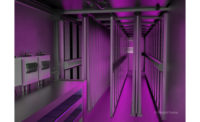How vertical hydroponic farming brings “local” to today’s cold food supply chains

Local food is difficult to scale. In fact, a national network of local food is a textbook paradox. While our nation’s global cold supply chain can bring bananas to Moscow, apples to Thailand and papayas to Dallas, it cannot bring consumers local produce.
Or can it?
Working solely within the confines of traditional agricultural, local throws a wrench into the links of the existing supply chain. That’s because local can’t be trucked, shipped or flown from afar. As soon as food leaves that 100-mile local radius, it stops providing the benefits of freshness, sustainability and transparency that makes local food so attractive in the first place. Year-round access to local food is also limited to specific areas of the country, where there is enough space, rain, sunshine and warmth to support continuous growing conditions. With these limitations in mind, it’s understandable why local has remained a small-scale concept.
Vertical hydroponic farming (VHF) takes the limitations of local and provides growers and suppliers independence from unpredictable variables such as rainfall, sun exposure and temperatures, to name just a few. Instead, VHF uses nutrient-rich water, LED lighting, hand-pollination and full environmental control to create the perfect day, every day.
The development of this technology means that crops can now grow indoors with greater precision and consistency than with traditional methods. As a result, suppliers are manufacturing a range of warehouse and modular container systems that deliver tangible, real-world applications.
VHF addresses the three most restrictive characteristics of local food—location, seasonality and scale of production. By eliminating dependence on soil, the number of potential farming sites increases exponentially. Parking lots, unused industrial spaces, rooftops—suddenly these areas become perfect locations for VHFs.
Plus, these fully-controlled systems create ideal year-round growing conditions, making it possible to grow food in inhospitable environments. The ‘V’ in VHF means the ability to grow in 3D. By taking advantage of a third growing plane, VHF can output several times more than the comparable amount of traditional land.
Year-round production. By maintaining perfect growing conditions at all times, VHF is able to reap harvests consistent in both quantity and quality. For a distributor or supplier, this means providing customers with a reliable source of local produce year-round without needing to source warm-weather fruits and vegetables from California or Arizona.
Consistent pricing. Consistent quantity and quality of produce means consistent pricing throughout the entire supply chain. Hydroponically-grown produce can reduce seasonal price fluctuations and take financial stress off suppliers, distributors and customers to make sure everyone is paying and earning fair prices year-round.
Long-lasting produce. Fresh fruit and vegetables grown in VHF systems last 2-3 weeks longer than their traditionally-grown counterparts since they no longer need to travel such long distances. This help makes cold storage timelines more flexible for suppliers, distributors and customers alike.
Easy integration. Since VHF can activate urban and industrial spaces, it’s possible to place a farm just steps away from the loading docks. Not only does this give distributors greater control over supply, but it also allows the produce to easily snap into existing supply chain operations without needing to coordinate additional logistics.
Damage control. In such cases of an E.coli outbreak, for instance, VHF would act as a dependable and alternative source for fresh fruit and vegetables that consumers could feel safe buying.
Agility. VHF systems allow distributors to react quickly based on customer demands and industry trends. Full environmental control means that plants growing in VHF systems grow faster than traditionally grown produce. Plants can go from seed to harvest in as little as six weeks.
Looking for a reprint of this article?
From high-res PDFs to custom plaques, order your copy today!





